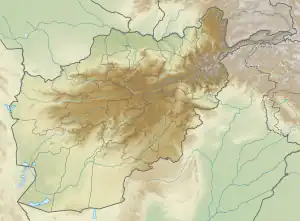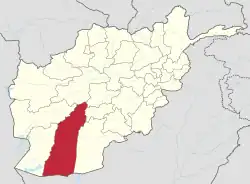Lashkari Bazar | |
|---|---|
Archeological site | |
.jpg.webp) Ruins of the Ghaznavid Palace of Lashkari Bazar, in Lashkargah (the South Palace, seen from the north).[2] | |
 Lashkari Bazar Location in Afghanistan .png.webp) Lashkari Bazar Lashkari Bazar (Continental Asia) | |
| Coordinates: 31°33′57″N 64°21′03″E / 31.565961°N 64.350822°E | |
| Country | |
| Province | Helmand |
Lashkari Bazar (Persian: لشگری بازار "Military market", locally known as Persian: کھنه قلعه Qala-e-Kohna "Old castle") was a palatial residence of rulers of the Ghaznavid Empire, located in Lashkargah in Afghanistan. The original name was probably al-'Askar.[3]
History
Some structural elements of the site date to the Parthian period.[3] The Center palace (32x52 meters) is thought to be dating from the Samanid period (819-999 CE).[3] The area had been conquered by the Arabs as early as 661 CE, and developed to become a large and wealthy city.[4]
The very large South Palace (170x100 meters) was probably founded by Mahmud of Ghazni (998-1030 CE), and expanded by his son Masud I (1030-41 CE).[3][5][6][4] The palaces in Lashkari Bazar were the winter retreat of the Ghaznavid rulers, whose capital was in Ghazni.[4] The South Palace was richly decorated with stucco, paintings, frescoes and carved marble panels.[3] A large market street about 100 meters long, a bazaar, joins the palace structure.[3]
The Northern palace was constructed by later rulers.[4][3]
The later Ghurid dynasty sacked the palaces in 1151 CE, but later restored them, and some portions of the architecture are attributed to them.[4][3] They built the fortress of Qala-e-Bost about 7 kilometers to the south, together with an architectural arch.
Recently the ruins have been inhabited by Afghan refugees fleeing Taliban violence.[7]
Paintings from Lashkari Bazar
.jpg.webp) Ghaznavid figures in the wall paintings from Laškarī Bāzār
Ghaznavid figures in the wall paintings from Laškarī Bāzār Painting from the Palace courtroom, Lashkari Bazar
Painting from the Palace courtroom, Lashkari Bazar Portrait from the Palace courtroom, Southern Palace, Lashkari Bazar.[8]
Portrait from the Palace courtroom, Southern Palace, Lashkari Bazar.[8]
References
- Schlumberger, Daniel (1952). "Le Palais ghaznévide de Lashkari Bazar". Syria. 29 (3/4): 257. ISSN 0039-7946.
- ↑ Schlumberger, Daniel (1952). "Le Palais ghaznévide de Lashkari Bazar". Syria. 29 (3/4): 257. ISSN 0039-7946.
- 1 2 3 4 5 6 7 8 Petersen, Andrew (1996). Dictionary of Islamic Architecture. Routledge. pp. 161–162.
- 1 2 3 4 5 Kipfer, Barbara Ann (29 June 2013). Encyclopedic Dictionary of Archaeology. Springer Science & Business Media. p. 576. ISBN 978-1-4757-5133-8.
- ↑ Schlumberger, Daniel (1952). "Le Palais ghaznévide de Lashkari Bazar". Syria. 29 (3/4): 251–270. ISSN 0039-7946.
- ↑ Fehérvári, Géza; Shokoohy, Mehrdad (1980). "ARCHEOLOGICAL NOTES ON LASHKARI BAZAR". Wiener Zeitschrift für die Kunde des Morgenlandes. 72: 83–95. ISSN 0084-0076.
- ↑ "Afghan war displaced settle in lost city". South China Morning Post.
- ↑ Murdock, Matthieu J.; Hritz, Carrie A. (1 January 2013). "A Report on Archaeological Site Stability and Security in Afghanistan: The Lashkari Bazar Survey". Cultural Heritage in the Crosshairs. Brill: 251.
